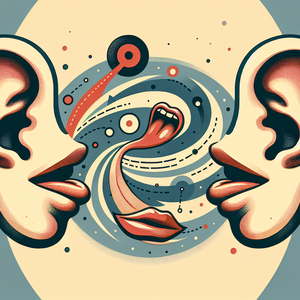Language Evolution: How Technology Shapes Our Communication of Emotions

The transition from traditional communication to digital platforms has birthed an entirely new vernacular. Emojis, for example, have emerged as a universal language, transcending cultural boundaries and allowing users to convey complex emotions succinctly. A simple smiley face can express friendliness and respect, while a frown or eye-roll emoji may convey annoyance or sarcasm. This visual language enriches our communication but can also lead to misinterpretations. Consider a workplace scenario where a colleague receives a message that reads, "I really need that report ASAP 😬." Depending on the recipient's perspective, the emoji could be interpreted as a light-hearted nudge or a passive-aggressive demand. This duality underscores the necessity of understanding the emotional nuances embedded in our digital expressions. A study by the University of Pennsylvania found that messages with emojis were perceived as more sincere, but the effectiveness varied based on the context and recipient.
Changing Norms of Politeness
The influence of technology extends to our understanding of politeness and professionalism. In professional settings, the use of informal language and abbreviations—such as "thx" instead of "thank you"—has gained acceptance. While this shift can foster a sense of camaraderie and approachability, it raises questions about respect and professionalism. Research published in the Journal of Business Communication found that employees who used casual language in emails were often perceived as less competent by their superiors, revealing a tension between friendliness and formality. Moreover, the fast-paced nature of digital communication can lead to hasty responses, increasing the potential for miscommunication. A message intended to convey urgency may inadvertently come across as brusque. For example, the phrase "Can you do this now?" might be interpreted by one person as a respectful request, while another may see it as an unreasonable demand. This discrepancy highlights the need for a nuanced understanding of digital communication etiquette, where the tone can significantly influence the emotional impact of our messages.
The Rise of Informal Language
The growth of informal language in digital communication is closely linked to the phenomenon of "code-switching," where individuals adjust their language and tone based on context and audience. On social media platforms, users often embrace a more casual style, which can lead to a dilution of traditional language norms. This blending of professional and personal communication styles poses challenges, especially for younger generations entering the workforce. A report by LinkedIn indicated that nearly 60% of hiring managers have encountered candidates who fail to demonstrate professionalism in their communications. This trend raises concerns about the potential for misunderstandings in professional environments, where the balance between respect and annoyance must be carefully maintained. The ability to navigate this shifting linguistic landscape is crucial for building and sustaining professional relationships.
Implications for Relationships
The evolution of language through technology influences not only individual interactions but also broader relational dynamics. Digital communication enhances connectivity, enabling individuals to maintain relationships across vast distances. However, it can also lead to superficial connections, as the absence of face-to-face interaction can diminish the depth of emotional exchanges. In personal relationships, the playful use of emojis and informal language can foster intimacy. For instance, couples exchanging light-hearted emojis may feel a stronger bond than if they communicated solely through formal language. On the flip side, in professional relationships, the misuse of these tools can create barriers. An overly casual tone might suggest a lack of respect, while a formal approach may come off as distant and unapproachable.
The evolution of language in the digital age has profoundly shaped how we communicate emotions, particularly respect and annoyance. As we navigate this new landscape, it is crucial to remain aware of the implications of our linguistic choices. By understanding the nuances of digital communication—such as the power of emojis, the shifting norms of politeness, and the rise of informal language—we can enhance our interactions and foster healthier relationships both personally and professionally. In a world where communication is increasingly mediated by technology, being mindful of our emotional expressions can bridge gaps, reduce misunderstandings, and ultimately enrich our connections with others. As we continue to adapt to these changes, the challenge remains: how can we effectively convey our emotions in a digital world that often prioritizes speed over clarity?
Digital Communication Specialist
Marketing agencies, corporate communications departments, non-profits
Core Responsibilities
Develop and implement digital communication strategies to enhance brand messaging across social media and online platforms.
Analyze audience engagement metrics to optimize content and ensure effective emotional resonance.
Collaborate with marketing and PR teams to create integrated campaigns that align with overall brand objectives.
Required Skills
Strong understanding of social media trends and digital communication tools.
Excellent written and verbal communication skills, with a keen eye for tone and audience appropriateness.
Familiarity with analytics tools (e.g., Google Analytics, Hootsuite) to measure campaign effectiveness.
User Experience (UX) Writer
Tech companies, start-ups, digital product agencies
Core Responsibilities
Craft user-focused content for websites, apps, and software interfaces, ensuring clarity and emotional alignment with user needs.
Collaborate with UX designers and product teams to create intuitive information architecture and content hierarchy.
Conduct user research to understand emotional responses to various content formats and styles.
Required Skills
Proficiency in creating concise, engaging copy that guides users through digital experiences.
Understanding of user-centered design principles and familiarity with UX design tools (e.g., Sketch, Figma).
Ability to adapt writing style based on user personas and emotional context.
Social Media Manager
Retail brands, media organizations, nonprofits
Core Responsibilities
Develop and execute social media strategies that reflect brand voice and engage target audiences.
Monitor and respond to user comments, messages, and reviews, using appropriate tone and language to maintain brand reputation.
Analyze social media performance metrics to adjust strategies and enhance emotional connections with followers.
Required Skills
Expertise in various social media platforms and their unique communication styles.
Strong skills in community management and customer service within a digital context.
Ability to create engaging multimedia content (images, videos, stories) that resonates emotionally with audiences.
Content Marketing Strategist
Marketing firms, corporate marketing departments, media companies
Core Responsibilities
Design and implement content marketing strategies that align with business goals and target audience emotions.
Conduct market research to identify trends in digital communication and emotional engagement.
Create and oversee content calendars, ensuring timely and relevant messaging across all channels.
Required Skills
Strong analytical skills to measure content performance and adapt strategies accordingly.
Excellent storytelling abilities, with a focus on emotional impact and reader engagement.
Familiarity with SEO best practices and content management systems (CMS).
Emotional Intelligence Trainer
Corporate training organizations, educational institutions, human resource departments
Core Responsibilities
Conduct workshops and training sessions on enhancing emotional intelligence in professional communication.
Develop training materials that incorporate best practices for digital communication and emotional expression.
Evaluate participants’ progress and provide feedback on their communication styles and emotional awareness.
Required Skills
Expertise in emotional intelligence frameworks and their application in workplace scenarios.
Strong presentation and facilitation skills, with a focus on interactive learning.
Ability to tailor content to diverse audiences, considering cultural and contextual nuances in communication.


